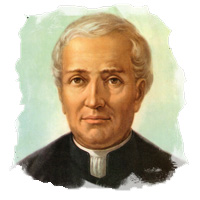The Christian Brothers, India
EDMUND RICE - THE STORY

Early Years
 One of the saddest and yet most human stories in the Bible is that of the Rich Young Man (Mt 19: 16-22).
It is the story of a good-living, aspiring disciple who asked the Lord what he must do to receive eternal life.
The answer: “Keep the Commandments”, to which the man honestly replied, “I have kept them from my youth.”
Then said the Lord, “Go sell what you have and give to the poor…….. and then come follow Me”.
The young man’s face fell when he heard this and he went away sorrowful, for he had great possessions.
One of the saddest and yet most human stories in the Bible is that of the Rich Young Man (Mt 19: 16-22).
It is the story of a good-living, aspiring disciple who asked the Lord what he must do to receive eternal life.
The answer: “Keep the Commandments”, to which the man honestly replied, “I have kept them from my youth.”
Then said the Lord, “Go sell what you have and give to the poor…….. and then come follow Me”.
The young man’s face fell when he heard this and he went away sorrowful, for he had great possessions.
 Many, many centuries later, another young man, Edmund Rice, asked the Lord the same question in prayer
and he heard the same answer. Edmund, however, did obey and sold what he had and he gave to the poor.
He became for the modern world the inverted parallel of the rich young man.
Many, many centuries later, another young man, Edmund Rice, asked the Lord the same question in prayer
and he heard the same answer. Edmund, however, did obey and sold what he had and he gave to the poor.
He became for the modern world the inverted parallel of the rich young man.
Edmund was born to Margaret Rice and Robert Rice in a place called Callan in Ireland on June 1762. The house where Edmund Rice was born is still preserved today and many pilgrims from all over the world visit this house in Westcourt, Callan. Edmund was part of a large family of seven sons and two-step sisters from his mother’s previous marriage. It was a typical Irish Catholic family but living in difficult times. During those days the Protestants who ruled Ireland disliked and mistreated the Catholics. Fortunately the Rice’s landlord was an understanding and kind man and the Rice family lived in peace. They were in fact considered quite wealthy for the time.
Edmund and his brothers would have gone to a small village school, where they would have learnt reading, writing, arithmetic and book-keeping all in the Irish language known as Gaelic. Later he completed his high school at Kilkenny.
Uncle Michael and Waterford
At 17, Edmund went to work for his Uncle Michael in Waterford, a port city. His uncle was a ship chandler. Edmund proved himself to be an eager learner and soon he could manage the entire business on his own, though he was just nineteen at the time.

Edmund's marriage and the death of his beloved wife
Edmund soon became a well-known figure in the town of Waterford. Because of the nature of his work, he made many contacts, mixing as he did in the best social circles. It was in 1785, at the age of 23 that he married a local, well-to-do girl, Mary Elliot. They lived in a large mansion at Arundel Place and were extremely happy. Also in 1785, Edmund’s uncle, Michael, died leaving Edmund his entire property and business. Edmund continued running his business and became well known in Waterford for his charity towards the needy and compassionate and towards the troubled and distressed, qualities that would lead to a radical change in his life. The future looked really bright for Edmund but God, as we know, works in mysterious ways.
Death of Edmund's Beloved Wife
In 1789, after a few short years of marriage, Edmund was given a difficult cross to bear. We are uncertain what exactly happened to his wife Mary, who was pregnant at the time. We do know she died suddenly but the doctor was able to save the child, a daughter. Edmund lavished all his love on his child whom he named Mary and tried to forget his terrible loss. Mary was delicate and mentally weak, so Joan, Edmund’s stepsister came to his large house in Arundel Place and helped to care for the little child Mary and look after the household chores.

Edmund's Struggle
“I was fortunate to have known and loved someone who was so perfect for me…. The Lord gave and the Lord taketh away, so blessed be the name of the Lord forever and ever”, was how Edmund referred to his misfortune later in life. After his personal tragedy, Edmund threw himself more than ever into what he had left - his career and his deep faith in the goodness of God.
He went about his charitable activities in the evenings after his work. We know that he also visited the convicts in the local prison and offered them solace and comfort.
One example of his practical caring for the poor and downtrodden was the story of Johnny Thomas, or ‘Black Johnny’, a Negro slave whom Edmund saw on a ship moored at the Quay. Moved by a natural sympathy for the victims of injustice, he purchased the young boy from the Captain of the ship and sent him to the Presentation Sisters to be educated. He subsequently provided Black Johnny with a house. Black Johnny started a small business of his own and became a well known personality in Waterford town. He too imbibed Edmund’s generosity and after he died was remembered for his charity and piety.
Another beneficiary of Edmund’s charity was a young Italian boy, Carlo Bianconi. He arrived in Waterford one day, wet and scruffy, selling paintings. Edmund befriended him and taught him English and helped him to start a small business. Carlo Bianconi went on to start the first horse drawn carriage service and accumulated great wealth. He later was elected the Mayor of an Irish town called Clonmel!
There is no doubt that Edmund had great compassion for the poor and under-dogs. In-spite of all these activities of selfless service, Edmund always felt that ‘something’ was missing from his life.

Where to Now?
On a business trip, Edmund Rice was in the company of a friar, (a priest belonging to a religious order) and invited him to share a meal and a room in an inn. Edmund awoke in the early hours of the morning and found the friar praying in a mood of simple peace and joy. So impressed was Edmund with the quiet holiness and simplicity of this monk that he seriously thought of entering a monastery and becoming a monk!
An important influence at the time was a conversation he had with a lady from Waterford whom he told about his intention to become a monk and live the rest of his life in a monastery. This rather practical lady brushed aside Edmund’s notion of becoming a monk. “Well, Mr. Rice, you are thinking of locking yourself away in a monastery? Will you leave all these poor boys roaming on the streets uncared for? Can’t you do something for them?”
We must not forget that Edmund at this time was about 31 years old. His personal assets and property were worth about twenty five thousand pounds, which by today’s standards would make him a millionaire! Yet, Edmund decided to sell all that he owned.
FROM ARUNDEL PLACE TO NEW STREET
The “something” that was missing from his life began to crystallize. He decided to leave the business he had inherited and built for nearly 20 years. He was giving up his life of luxury, his beautiful house, and his high position in society. Heavy-heartedly, he also made a choice to leave his handicapped daughter to the care of his step-sister. He had, at this stage, no real knowledge of where this would all lead. He took the risk and left it all in the hands of God. His friends called it an act of “mad folly”.
Edmund purchased a large stable in the New Street area of Waterford. He had the ground floor transformed into three classrooms and the space over the classrooms he made into three crude bedrooms. These actions were to many, incomprehensible. Here was a businessman with no formal training setting himself up as a teacher of Waterford’s most scruffy, poverty-stricken and undisciplined boys. Edmund himself may have had his doubts but he put a serene faith in God that the future would bear fruit for those whom he loved most – the poor.
There were only six pupils on the first day, but it was a start. The boys who came were rough, hardened and uncouth, owing to by years of living on the streets. Call it cajoling, enticement or his own magnetism, but it wasn’t long before the three classrooms were filled. Voluntary workers came forward to help him but soon left when they found it a Herculean task just trying to control the unruly mob, let alone teach them! To add to this, his neighbours complained of the disturbance and resented the presence of the riff-raff in the respectable neighbourhood and suggested that the boys would be “happier in their ignorance”.
Soon, as if in answer to Edmund’s prayers, two young men, Thomas Grosvenor and Patrick Finn offered themselves to Edmund, not merely to help in teaching but also to join Edmund in the religious congregation they knew he wished to establish for the education of the poor.
And so it was that Edmund, Thomas and Patrick took up residence above the stable school and thus began the very first community of Christian Brothers.

Growth and the formation of the Christian Brothers
In 1802, Edmund took a crucial step towards establishing a fully-fledged religious congregation, recognized by the Pope in Rome. He commenced building a monastery in the southern area of Waterford. The building was large and comprised a school and monastery that could accommodate 7 Brothers and was named Mount Sion. It was in 1804 that the pupils of New Street were transferred to Mount Sion. Edmund not only educated the children, but he also fed and clothed them. He built a bake-house for baking bread and also a tailoring shop, which turned out warm clothes for his boys.
Edmund knew only too well the futility of trying to educate children who were hungry and cold. Edmund also set up a lending library (an altogether new move for the time) at Mount Sion. Books were lent out to the boys on Fridays so that the boys could read them for their largely illiterate parents at night on Saturdays and Sundays!
It was also at Mount Sion that Edmund laid stress on the teaching of morals and good values to the boys apart from the usual academics; a practice that is held dear to the Brothers even today. The good news of Edmund’s educational crusade on behalf of the poor soon spread beyond the boundaries of the city of Waterford. Other cities got to hear about his work, and because the social conditions of the poor were much the same in every part of the country, a number of cities and towns expressed the wish that Edmund would open a school for their poor. So keen were the people to have schools run under Edmund’s educational system that the next school Edmund opened in Carrick-on-Suir was entirely built by the people of that town. Not only did the number of schools grow but also many young men attracted by the life and work of Edmund, joined him in his life and work.
The Christian Brothers
Deep satisfaction came on August 15th, 1809 when, with special permission from the Vatican, Edmund Rice and his followers finally took Vows (sacred promises to God) of Poverty, Chastity, Obedience, Gratuitous (free) instruction of youth and Perseverance in the Congregation. They also put on the habit (long, black gown of a religious order). Each took a new name. Edmund Rice became Edmund Ignatius Rice, taking the name of the founder of the religious order called the Jesuits.
Edmund and his Brothers drew up a Rule or plan of life, which they hoped to follow, and which they knew would bring them closer to God. This plan was submitted to the Vatican in Rome for approval. Pope Pius VII approved this Rule on 5th September 1821 by what is known as a Papal Brief. Some of the Brothers were not keen to accept this new Rule inspite of Edmund’s efforts to persuade them of its merits. These Brothers separated and continued to follow the rules Edmund had originally drawn up which were based upon the Rules of the Presentation Sisters. These Brothers are known today as the Presentation Brothers. This disappointment notwithstanding, it must have been a source of great pride and joy for Edmund and his Brothers to be recognized as the very first Congregation of male religious in Ireland known as the Institute of Christian Brothers. A General Chapter (Meeting) was held and Edmund was unanimously elected the first Superior General Leader. (It is a matter of great pride and happiness for us in India, that the previous Superior General was an Indian Brother, Br. Philip Pinto from New Delhi. He was the 15th Brother after Edmund to hold that post).

Obstacles and Trials
As can be expected, Edmund encountered many obstacles and controversies along the way. He was sometimes the object of vicious rumours. Edmund also had financial worries and legal battles to fight. The money he had soon ran out and the Brothers had to face desperate times. There were times when the Brothers had to beg from door to door to get funds to keep their schools running. Edmund thought that it was necessary to start ‘pay schools’ where those who could afford to pay fees would be charged so as to benefit those who were too poor to pay. However, this went against the Rules approved by Rome and a new permission had to be sought.
Throughout this period of acrimony, squabbling and rumour mongering, Edmund’s confidence in Providence and his own vision remained unshaken, trusting that everything he did, he did for the greater glory of God.

The Future
Edmund Lives
In December 1841, Edmund became seriously ill and the Brothers feared that his end was near. However his strong constitution asserted itself and he was, amazingly, able to attend to his correspondence, though he was confined to his room in his beloved Mount Sion. No doubt he reflected with gratitude on the growth of that little school in a stable in New Street to schools he lived to see established in Ireland, England, Gibraltar and even far off Australia. He thought about his childhood and family in Callan; his gracious and loving wife Mary; his handicapped daughter, Mary (who would outlive him by some 17 years) and the many who had been companion to him through his joys and trials. And above all he prayed. In 1842, his mental faculties began to fail and he spent periods between lucidity and a state of semi-coma. He died shortly after 11 am on August 29th, 1844 aged 82, whilst in the company of many of his Brothers.
A Protestant writing to his friend said, “People believe that he was a messenger of God. I knew Mr. Rice well. Who could stand by his grave and witness unmoved the wave of sorrow of the vast crowds? … I was almost moved to cry out, ‘Why are you sorrowful? Why are you sad? Mr. Rice is not dead. Yes he lives – the highest, noblest and greatest life. He lives in the noble band of Christian Brothers whom to whom he has bequeathed his spirit and his work.’’
The Future
After his death Edmund’s vision and mission continued to flourish. The Christian Brothers schools extended to New Zealand, Newfoundland, India, South Africa and Rome. In the 20th Century the Brother’s missionary work has spread to Africa, Papua New Guinea and North and South America. In recent decades although the number of vocations to the Christian Brothers has declined the spirit of Edmund has found fresh expression through a growing network of lay people devoted to Edmund’s vision and involved in ministries associated with the Christian Brothers. In 1996 Edmund Ignatius Rice was beatified (declared “Blessed”) by Pope John Paul II. Beatification is not to reward individual holiness but to strengthen the faith of a community. It highlights particular charisms and virtues, which are needed for our times. A ‘Blessed’ or a ‘Saint’ is a beacon of hope and a witness to specific human values.
Edmund’s long and extraordinarily varied life reminds us that we never stop growing, learning or developing. Edmund Rice at the age of forty could have been excused for thinking that his life’s achievements were behind him – what he did in the remaining forty-two years tells us that we never know when God will intervene dramatically in our lives, and that, as Cardinal Newman put it, “to be human is to change and to be perfect is to have changed often”.
Acknowledgments:
A Quiet Revolution: Anthony J Shanahan cfc;
Edmund Ignatius Rice: Patrick B Jacob cfc;
Edmund Rice: A Man and his Times: Desmond Rushe;
God is in the Ordinary: Teresa Pirola ;
A Tree is Planted: Columba Normoyle cfc ;
Edmund Ignatius Rice - A story of Compassion. Sketches painted by Anirban Sengupta- Std 7B (St. Augustine’s, Vasai)

